Fall in Yosemite is a special time! Here is everything you need to know about visiting Yosemite in autumn, from weather, scenic spots to photograph the foliage, what to expect, and more!
Yosemite National Park is a magical place at any time of the year, attracting millions of visitors each year who come to see its towering granite rock formations and beautiful waterfalls. Fall in Yosemite is especially breathtaking – the valley is transformed as it turns into breathtaking shades of orange, yellow, and red.
California isn’t exactly known for its seasons, but autumn in Yosemite is one of the best ways to experience the season in the state.
When I started seeing stunning photos of the fall colors in Yosemite pop up on Instagram, I knew I would have to make a trip there to see it for myself! So, we set off on a weekend trip from San Francisco and marveled at the beauty of the park.
California has no shortage of amazing and unique National Parks (such as Joshua Tree and Death Valley), but the Yosemite fall colors are truly like no other.
I am now convinced that it is the best time to visit the park, particularly if you visit Yosemite in October or early November. Not only is the Yosemite fall foliage spectacular, it is far less crowded and much more affordable! Of course, there are some cons to visiting Yosemite in autumn, which I will cover as well.
Keep reading for everything you need to know about visiting Yosemite in fall (as well as plenty of photos to entice you to go)!
Disclosure: This post contains affiliate links. This means that if you make a purchase or booking, I may receive a small commission at no additional cost to you. Pictures & Words is a participant in the Amazon Services LLC Associates Program, an affiliate advertising program designed to provide a means for us to earn fees by linking to amazon.com and affiliated sites at no cost to you.
Things to Know About Fall in Yosemite


Fall Weather in Yosemite
Autumn in Yosemite brings somewhat unpredictable weather – but in general, temperatures are relatively mild and the weather is perfect for hiking!
If you visit Yosemite in September, it will probably still be a bit warm. However, it tends to cool down if you are coming to Yosemite in October, and especially in November.
It gets hot AF in the summer, and hiking gets infinitely more challenging because of it. Many of the trails have a lot of exposed areas, and hiking in the heat in full sun is NOT fun…but fall brings much more comfortable temperatures, which makes it one of the best fall getaways in California.
Average fall temperatures in Yosemite are as follows:
- Yosemite in September: 84 degrees Fahrenheit (28 degrees Celsius) / 50 degrees Fahrenheit (10 degrees Celsius)
- Yosemite in October: 72 degrees Fahrenheit (22 degrees Celsius) / 41 degrees Fahrenheit (5 degrees Celsius)
- Yosemite in November: 57 degrees Fahrenheit (13 degrees Celsius) / 32 degrees Fahrenheit (0 degrees Celsius)
Even still, there can still be great variation in the actual day-to-day temperatures. It can be warm one day, and then snow the next! You can also expect chilly temperatures at night – be prepared with a warm jacket, and plenty of layers that you can take off as you get warm. Bring extra warm gear if you’re camping!
While November-March sees the most rainfall, there is usually no significant precipitation in Yosemite in September or October. However, higher elevations may already get snow by this the end of October. In fact, you might already get freezing temperatures at those elevations by September.
Autumn in Yosemite can bring some schizo temperatures. With this in mind, check the weather and road conditions before you go!
We visited Yosemite in November (the first weekend) and knew it would be a bit of a gamble, but ended up getting super lucky – it was 73 degrees the first day, and 60 degrees the next. We were SUPER fortunate because not only was the foliage at their peak autumn colors, all of the roads were still open!

Which park entrance to use in Yosemite in autumn?
There are five entrances to Yosemite National Park:
- Big Oak Flat Entrance (Highway 120): The most direct way into the park if you are driving from the Bay Area.
- Arch Rock Entrance (Highway 140): Another entrance you can use if coming from the Bay Area. It turns into El Portal Road, which leads straight into Yosemite Valley.
- Hetch Hetchy Entrance (Highway 120): This entrance is located further north. It’s not as direct if coming from the Bay Area, but it sees far fewer crowds.
- South Entrance (Highway 41): This is the entrance you will use if driving from destinations south of the park, like Los Angeles or San Diego.
- Tioga Pass (Highway 120): For those coming from Las Vegas, Death Valley, Lake Tahoe, and Mammoth Lakes.
All of the park entrances are fully open early on in the fall season (September-mid October), however, do check conditions if you are visiting later in the season. Tioga Pass does shut down whenever the first snowfall of the season is – this can occur as early as late October. The Hetch Hetchy entrance usually closes sometime in November.
If you are planning to come to Yosemite in late October or November, be sure to check live road conditions leading up to your visit. Also have a plan B in place in case roads shut down.

What Month is Best to Catch Yosemite Fall Colors?
In general, late October is the best time to see fall colors.
Yosemite in September is still kinda hot and there won’t be much to see in terms of foliage. And trust me, you WANT to see the foliage! Visiting Yosemite in November is a bit of a gamble. Mid to late October is when you’ll likely hit the winning combination of spectacular fall colors, perfect weather, and ideal road conditions!
However, the best time for Yosemite fall colors varies from year to year. The best way to keep track of when peak foliage hits is to check the California fall color map. This will allow you to see when the leaves are starting to turn, and when the peak is approaching!
You can also check this Mono County fall color report for conditions in Tioga Pass.
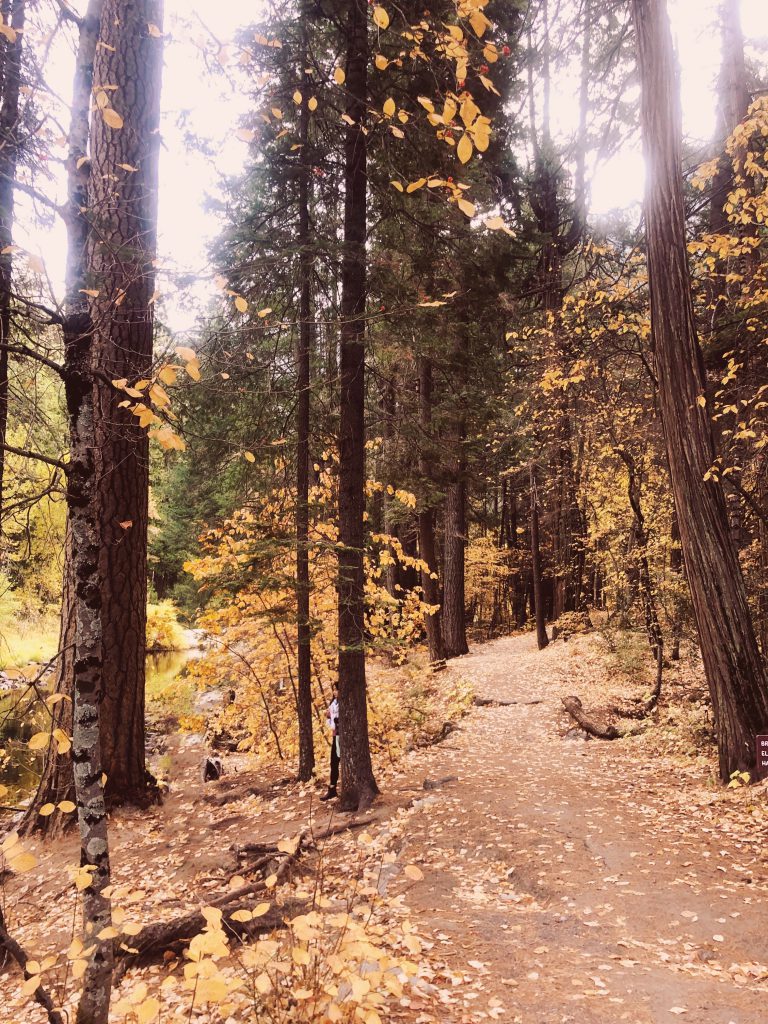
Are Reservations Necessary to Visit Yosemite in Fall?
In 2024, you must make a reservation if you plan to visit Yosemite National Park on weekends and holidays (Labor Day and Columbus Day), through October 27. A park reservation is required to enter the park between 5am and 4pm.
Most reservations were released on January 5. However, you can still make a reservation 7 days in advance of your visit at 8am PST on Recreation.gov. For example, if you plan to visit October 27, you will have to make your reservation on October 20.
They go quickly, so be sure to be ready right on the dot at 8am! This means you should already create your Recreation.gov account in advance and be logged in and on the correct page.
There is a $2 non-refundable reservation fee. This is in addition to the $35 park entrance fee you will pay when you visit.
Do note that reservations are not necessary if you have a permit for Half Dome or a wilderness permit, or if you booked a stay at a campground, or in one of the park’s accommodations. They are also not required for private lodging or vacation rentals in Wawona, Yosemite West, or Foresta.
Learn more about park reservations on the NPS website.
Advantages of Visiting Yosemite in the Fall Months
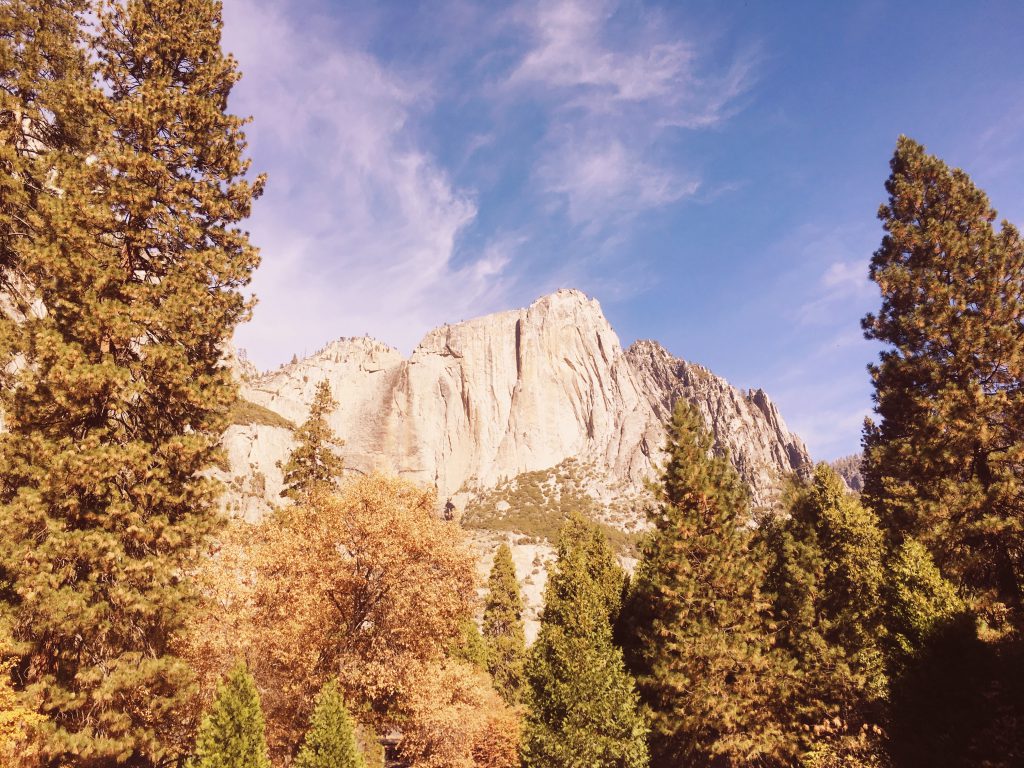
There are far fewer crowds in Yosemite in autumn
Aside from the beautiful fall foliage, this is perhaps the BIGGEST advantage to visiting Yosemite in fall!
Yosemite attracts over 4.5 million people a year, making it one of the most popular National Parks in the United States. Many of these visitors visit during the summer months.
Over the years, I’ve visited Yosemite during the summer several times, and it is crowded AF.
You’ll encounter traffic as you approach the entrance and it is common to be waiting over an hour to get into the park. I’ve heard horror stories of people waiting for over 2 hours at the entrances on the weekend – not fun!
The trails and the viewpoints are also packed, especially on the most popular hikes.
After Labor Day, however, the crowds thin out considerably. By October in Yosemite, there is a considerably more peaceful feeling in the park, letting you enjoy all that picturesque scenery without dealing with tons of people all up in your space!
Accommodations are cheaper and easier to secure
Fewer tourists coming to Yosemite in autumn means that accommodations are much cheaper. You also don’t have to worry about booking months in advance! This makes it much easier to plan a relatively spontaneous trip.
When we tried to plan a trip two weeks ahead of time in the summer, we ended up having to stay in Modesto – two hours away! When we planned a fall trip to Yosemite with just about the same amount of lead time, we found a relatively good deal ($150/night) for an inn just 20 minutes outside of the park.
Campground reservations, which can be booked up to six months in advance in the summer, are also much easier to secure if you visit in the fall. However, do note that the temperatures at night do get pretty chilly by October in Yosemite.
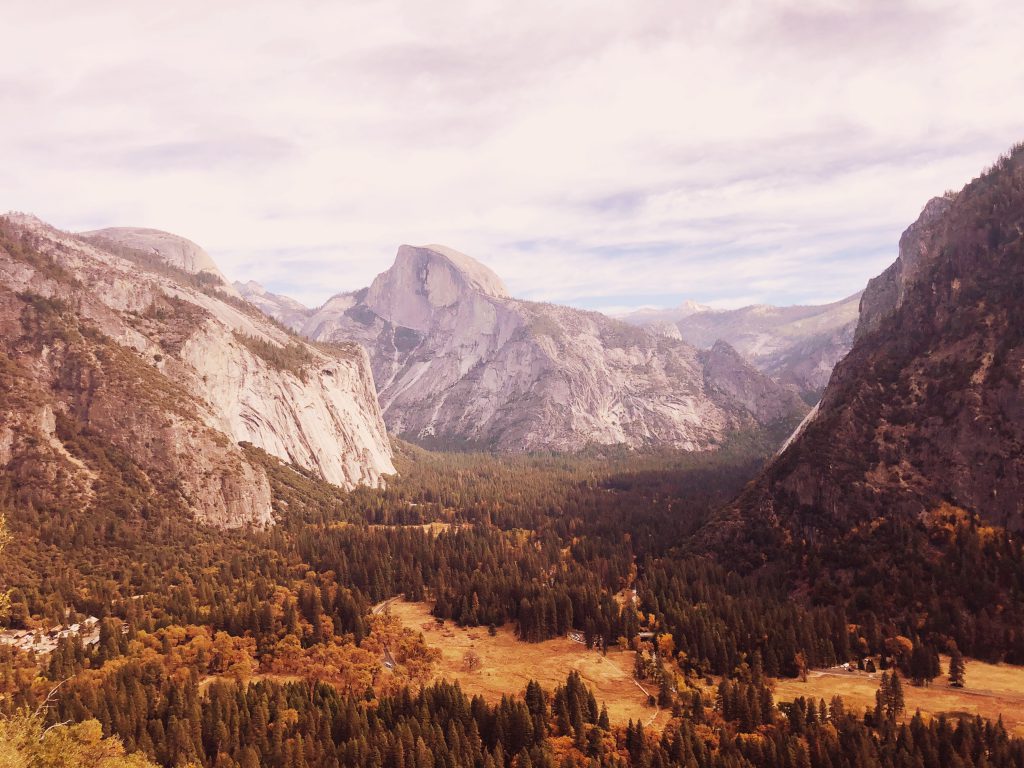
Hiking trails are much less crowded
Because Yosemite sees the bulk of its visitors in the summer months, its trails tend to be CROWDED.
You’ll be elbow-to-elbow with other hikers on the most popular hikes in the park. We once hiked the Mist Trails over Fourth of July weekend (not the best idea but oh well lol) and it was sooo crowded. We had to wait a bit to get up the stairs because they were pretty narrow and there was a giant crowd of people. Not pleasant!
While September can still see a few crowds, by October in Yosemite, they thin out considerably. This means that the most popular hikes will be far less crowded as well!
Another advantage : if you are trying to secure day-of permits for Half Dome, you’ll have a much better chance of winning the lottery in the fall months (especially October) since you’ll be competing against far fewer people for them.
While, yes, the waterfalls do run dry, there’s still plenty of epic hikes that you can do in the park in the fall months!
Weather is perfect for hiking
And on that note – the summer months tend to be HOT! Some of the most popular trails are in full sun, and there is no shade. Some days, it can get over 90 degrees – NOT fun at all!
The fall months bring about much milder temperatures, which are perfect for hiking. It certainly makes for a much more pleasant experience!

The Yosemite fall colors are SPECTACULAR!
Before visiting Yosemite National Park in fall, I’d heard that the foliage was pretty, but I was truly blown away by exactly how beautiful it was!
The park’s foliage gets transformed into a spectacular display of colors. If you are visiting Yosemite in October (specifically mid to late October), you are in for an absolute treat!
You can see fall colors all over the park, but they are especially concentrated in the Yosemite Valley. I have some recommendations below on the best places to see the Yosemite fall foliage – the best viewpoints, hikes, and photo spots so keep on reading!
Cons of Visiting Yosemite in Autumn
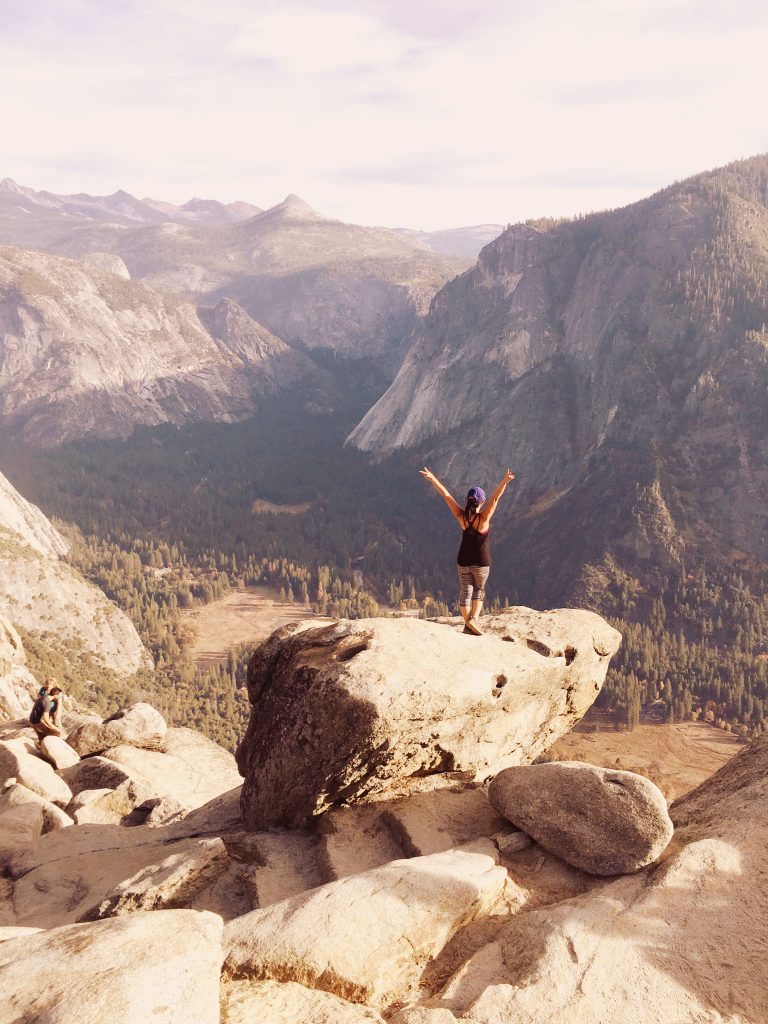

Waterfalls usually run dry
When visiting Yosemite in the fall, be aware that the waterfalls will probably be dry. I would say that this is the biggest con to visiting Yosemite in September, October, or November. However, do not let this deter you from coming – the rest of the park is still absolutely spectacular and will be well worth the visit!
However if you end up visiting during a particularly rainy year, or right after significant rainfall, you might still be able to catch some flow in the waterfalls!
Upper Yosemite Falls will most likely be dry
Knowing this, we still ended up hiking to Upper Yosemite Falls anyway. Part of this reason was that we only had one full day in Yosemite but ended up getting a late start. We wanted to hike to Clouds Rest, but we knew there was no way we’d complete it in time before sunset.
We were looking for a hike that was challenging but would only take 4-6 hours – Upper Yosemite Falls fit our criteria perfectly. We ended up asking the rangers at the visitor’s center, who told us that there would be no water flowing, but it was still well worth doing because the views from the top were still pretty gorgeous.
I totally agree. Plus, there are some pretty epic views of Half Dome throughout the trail. It is definitely a challenging hike (coming down is almost as hard as going up, and I was cursing myself towards the end). It’s important to keep your expectations in check if you are visiting Yosemite in fall and are considering doing the hike!


What Vernal Falls and Nevada Falls are supposed to look at when they’re at full flow
Bridal Veil, Vernal, Nevada, and Lower Yosemite Falls run year round, BUT…
…the water flow usually slows down to a trickle, especially at Bridal Veil.
Vernal Falls and Nevada Falls, which are the highlights of the Mist Trail, are fed by the Merced River so they tend to have a little bit more water flowing. However, it will have slowed down considerably compared to the spring and summer months, which is a bit of a disadvantage of visiting Yosemite in October or November.
If you are planning to hike the Mist Trail, do be aware that you might not get very much mist, which might be a disappointment since “mist” is in the name.

Some Roads May Be Closed if You Visit in Late Fall
Be aware that the fall season may bring about some road closures in Yosemite, especially later on in the season. Most notably – Tioga Pass Road and Glacier Point Road may be closed due to snowfall if you visit too late in the fall.
These are the notable seasonal road closures you should be aware of:
- Tioga Pass Road climbs over 4000 feet up from Yosemite Valley and leads into the park’s High Country. Some notable spots along Tioga Pass include North Dome, Tolumne Meadows, Olmstead Point, Tenaya Lake, and the trailhead for the Clouds Rest hike.
Because Tioga Pass is at a higher elevation, it might see freezing temperatures by September, and may be shut down by the end of October or early November. Once the road shuts down, it is also not possible to enter the park from its east entrance.
- Glacier Point Road leads up to the popular viewpoint of the same name, as well as Taft Point, Sentinel Dome, and Dewey Point. It is usually snowed in by mid-November. Glacier Point and Taft Point were two of my absolute favorite viewpoints in the park – not gonna lie, I would’ve been disappointed if the road had shut down before my visit.
- Mariposa Grove Road also shuts down in the winter, usually at the end of November.
We took a gamble by coming to the park in early November, but for the best chance of all roads being open, I recommend visiting Yosemite in October.
Check the latest road conditions before you go – the page will also tell you exactly when these roads have shut down in past years!
Things to Do in Yosemite in Fall

Where to See and Photograph Yosemite Fall Colors
Hands down, the best part about fall in Yosemite! California may not be known for its fall foliage, but the Yosemite fall colors are another story – it is absolutely spectacular!
The best spots to see fall foliage in Yosemite are mostly in the valley, where you will see the leaves on the oak, maple, and dogwood trees turn into vibrant shades of orange, yellow, and red. At higher elevations, the trees are mostly evergreens, so you won’t see the colors turn the higher you go.
As you drive into the valley, you are sure to see plenty of gorgeous foliage – which stand in beautiful contrast against the giant granite rocks. We spent some time just driving around and stopping for photos every so often, ooooh-ing and aaaah-ing over all the colors – definitely a highlight!
Here are my favorite photo spots to capture fall colors in Yosemite:

Valley Loop Trail
We found the Valley Loop Trail as we were driving around – we saw some yellow trees, so we parked and decided to explore. The entire trail is 11.5 miles and takes you through several meadows and past some of the most dramatic cliffs in the valley. It also connects into Bridal Veil Falls and the Half Dome Village.
If you choose to hike the entire loop, it will take you around six hours. It’s also a popular trail for biking as well, and you can find rentals in the park.
We hiked just a short part of the trail and found lots of beautiful foliage! We also found a little creek just off the trail – we especially found the reflections of the leaves and the rocks to be especially stunning, and one of the most beautiful places in Yosemite in the fall.


Sentinel Bridge
This stone bridge stands above the Merced River, at the footprint of where the old Yosemite Village once was. You’ll see the foliage around the river turn into beautiful shades of orange and yellow, and you can see those colors reflected into the waters. You’ll also catch a perfect view of Half Dome as well!
Swinging Bridge
This wooden bridge doesn’t actually swing (it used to back in the day, though!) but has one of the best views in the park. If you’re lucky, you’ll see Upper Yosemite Falls reflected into the river here. Even if the falls aren’t flowing, it’s still a gorgeous view of the valley and meadows, especially once the foliage turns into spectacular fall colors!

Sentinel Meadow/Cook’s Meadow Loop
If you’re looking for a short, easy hike that also lets you view the best of the fall colors in Yosemite, I highly recommend the Sentinel Meadow/Cook’s Meadow Loop!
This short, 1-mile hike takes you through a wide-open meadow that borders the Merced River. There are tons of yellow trees, as well as golden grass, and gorgeous views of the Yosemite fall foliage! I think shooting photos here during golden hour would make for some pretty incredible shots – but we were there midday and still ended up with some gorgeous photos!


The trail will also give you some epic views of some of Yosemite’s most iconic sights, including Half Dome, El Capitan, and Yosemite Falls, all of which are gorgeous as a backdrop to all those fall colors!

Yosemite Valley Chapel
The Yosemite Valley Chapel is a hidden gem in the park, located along Southside Drive right off the Cook’s Meadow trail. Built in 1870, the chapel is the oldest standing structure in the valley.
The simple, small church is painted in vibrant burnt orange and yellow paint. This makes the perfect contrast against the fall colors!
I actually didn’t have a chance to stop here on my fall trip to Yosemite (I’ve only visited on a summer trip), but I’ve seen tons of photos of the chapel against the fall foliage here and it looks absolutely gorgeous!
Other Scenic Spots You Should Not Miss at Yosemite in Autumn

Taft Point
This is one of Yosemite’s most dramatic viewpoints – you’ll come to a spectacular overlook of the Yosemite Valley, Yosemite Falls, and El Capitan. You can really see how grand the valley is from here!
To get here from the Yosemite Valley, take Wawona Road (the continuation of Highway 41 within the park) for 13 miles, then turn onto Glacier Point Road. Continue for about 13 miles to reach the trailhead. The hike is 2.2 miles roundtrip, and is relatively easy.


The hike starts off as your average walk in the woods, until you start reaching the end. There, dramatic cliffs lay out before you. Be sure to check out the Fissures, where you will see a giant slit in the valley wall – it’s super cool!
Then you’ll get to the viewpoint itself. The views from here are absolutely spectacular. You can walk up to the edge of the cliff to really get a sense of how big Yosemite is, and how high up you are from here! I highly recommend it (unless you are scared of heights) – it gives you such a unique perspective of the valley. Just be super careful and don’t get too close to the edge, as people have fallen off and died here.
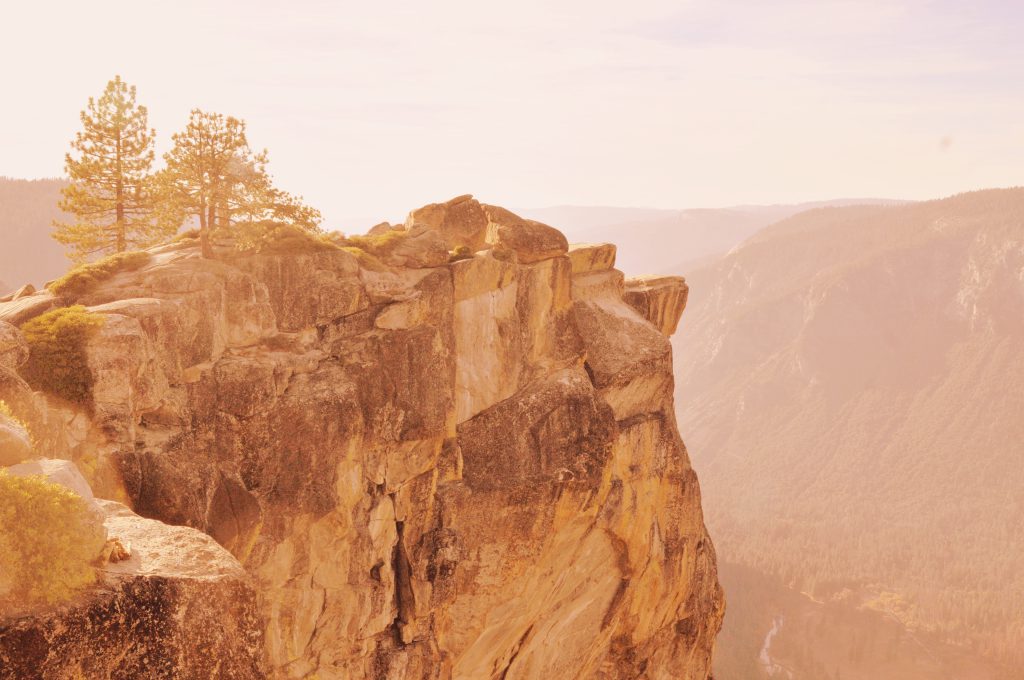
The light here is especially gorgeous at golden hour and you can snap some beautiful shots – definitely a highlight of any visit to Yosemite! Afterwards, you can head towards Glacier Point to catch the sunset.

Glacier Point
Do yourself a favor and watch the sunset from Glacier Point – it is absolutely magical! This is hands-down Yosemite’s best viewpoint, and it is especially gorgeous when you see it against those sunset colors.
You’ll stand 3200 feet above the Yosemite Valley and get a breathtaking view of Half Dome, Yosemite Falls, and Yosemite’s High Country. Words cannot do justice here – it left me absolutely speechless.
By visiting Glacier Point and Yosemite in the fall you have a huge advantage – the crowds are much thinner here. During summer, it can be an absolute zoo and finding a spot to sit to watch the sunset is almost impossible!


To get here from the Yosemite Valley, take Wawona Road (the continuation of Highway 41 within the park) for 13 miles, then turn onto Glacier Point Road. Continue for about 15 miles – or 2.5 miles from Taft Point. The trailhead is at the end of the road. The drive takes about an hour, and is absolutely worth the trek for those spectacular views!
You can also hike there via the Four Mile Trail, Panorama Trail, or Pohono Trail, which are all strenuous hikes. Or, you can take a bus from the Yosemite Valley and then hike back down – a much better option. (**note: the Glacier Park shuttle bus currently not operating at this time)
While Glacier Point Road shuts down due to snow in the late fall and winter, it is also a very popular spot for cross-country skiers.

Tunnel View
Tunnel View is perhaps the most famous viewpoint in Yosemite National Park – this iconic view of the Yosemite Valley was made famous by Ansel Adams.
It’s easy to see why it inspired the famous photographer – you can photograph some of Yosemite’s most famous landmarks in one spectacular shot. You will see El Capitan and Bridal Veil Falls in the foreground, with Half Dome peeking through in the back.
The view may be more beautiful in the spring and summer when Bridal Veil Falls has a lot of water flowing from it. However, you can see the fall colors of the trees, which still makes stopping by Tunnel View well worth it!
Tunnel View is an easy stop on the way to Taft Point and Glacier Point – it is at the east end of the Wawona Tunnel along Wawona Road (the continuation of Highway 41 inside the park).
More Yosemite Travel Tips

What to Pack for Fall in Yosemite
- A jacket: It gets chilly at Yosemite in the fall, especially at night! A packable puffer like this one is a great choice, because it keeps you warm when you need it, but you can fold it up and throw it in your bag when you don’t need it.
- Layers: Since the weather is so variable at, dressing in layers is key! Be sure to pack some base layers – I travel with these ones. I also pack a flannel button-down as these make an excellent layering piece!
- Good hiking shoes: You’ll want a sturdy pair of hiking shoes, especially on the more challenging hikes (like Upper Yosemite Falls, which gets SUPER slippery). I just snagged a pair of these Merrell Siren Edge shoes and absolutely LOVE them – I usually haaate hiking shoes because they are too bulky, these are super lightweight (almost like sneakers) but with plenty of grip and traction.
- Cute boots: For when you aren’t hiking (or only doing light hikes) and want to look cute in photos! The boots I’m wearing in most of these photos are this pair – they are super rugged and comfortable, which are perfect for some light hiking AND they’re cute! If you want a bit more warmth, I live in these boots in the fall – they’re cute, comfortable, and waterproof. If it’s super cold, these are my go-to cold-weather boots – warm, comfy, and waterproof.
- A scarf – I’m wearing this one in my photos, and it is my favorite! It’s cute, lightweight, and warm.
- Day Pack: Something like this backpack is perfect for holding all your gear, snacks, camera equipment, and more Yosemite fall visit. You can also get a hydration pack for easy access to your water.
- Water: And speaking of water…carry plenty of it – even if the temperatures are mild! I carry this water bottle with me everywhere I go, and I love it for hiking because it’s insulated and the water stays cold. It also comes in a variety of sizes to suit your needs.
- Flashlight or Lantern: Especially if you plan to hike around sunset – you don’t want to be caught in complete darkness! It started getting super dark while hiking back from Upper Yosemite Falls, and we were glad that we had this collapsible lantern with us!
- Trekking Poles: They will definitely help you on the harder hikes (they were a lifesaver going down from Upper Yosemite Falls). Get a collapsible pair like these so they fold up easily into your bag.
- Battery Pack: I never travel or hike without this one. It can charge up to five times on one full charge!
- First Aid Kit: Be prepared, just in case! This one is compact but has all the essentials.
- Snacks: I always have some protein bars on hand to fuel me up on a hike. These Think bars are my favorite!
Other Things to Know About Visiting Yosemite National Park
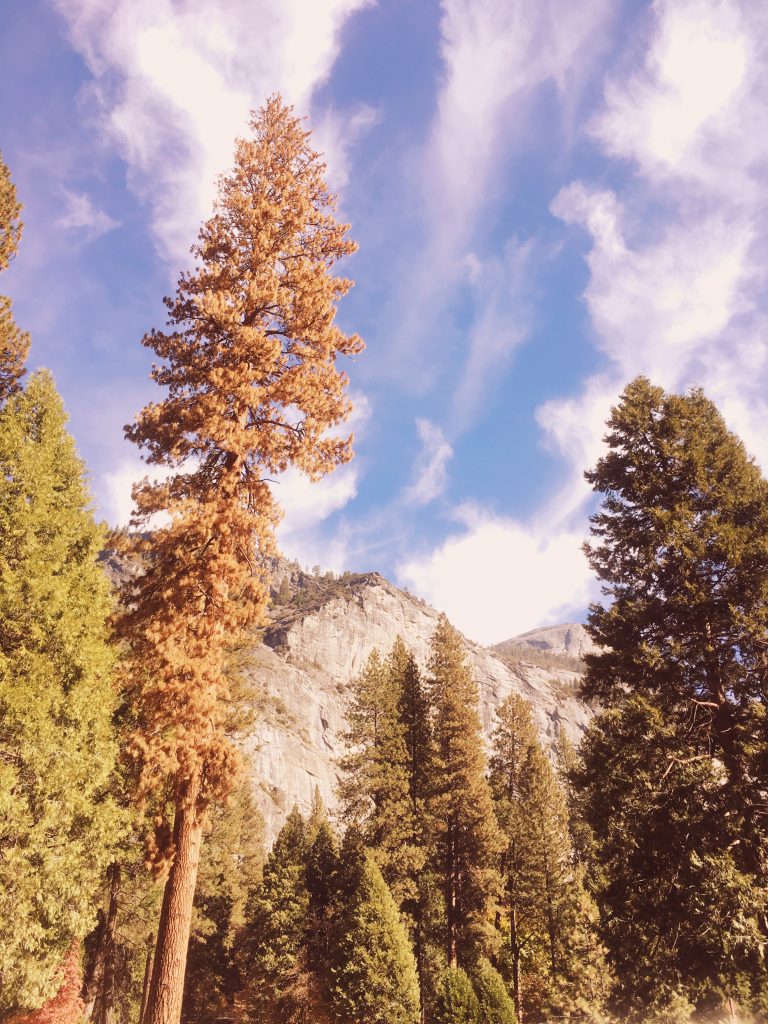
Entrance Fees
The day use fee for Yosemite National Park is $35 per vehicle – this is valid for up to seven days.
If you plan to visit other national parks throughout the year (such as Joshua Tree and Death Valley), you can also purchase an annual interagency pass for $80 – I highly recommend this! You only need to visit three parks to get your money’s worth.

How to Get to Yosemite National Park
Yosemite National Park is basically located right in the center of California, making it easily accessible no matter which direction you come from – it’s an easy weekend trip from both San Francisco and Los Angeles (and Orange County as well).
What Airport Should I Fly Into?
The closest airport to Yosemite National Park is Mammoth Yosemite Airport, a small regional airport located about 40 miles (~45 minutes) from the park. Fresno Airport is another regional airport, located about 65 miles (~2 hours) from Yosemite Valley. Flights are limited from these two airports.
The nearest international airport is Sacramento International Airport (SMF), located 150 miles (~3 hours) away from the park and offering flights to many major US cities, as well as destinations in Canada and Mexico.
The two closest major international airports are San Francisco International Airport (SFO), which is located 170 miles away (~3 hours 15 minutes); and Los Angeles International Airport (LAX), which is 280 miles (4 hours 45 minutes) away. From here, you can connect to almost anywhere in the world. SFO and LAX are also served by almost every major car rental company, so renting a vehicle is also a breeze.
For more information about driving distances and directions from various California cities and destinations, see here.

Park Entrances
Yosemite National Park has five different entrances. If you are coming from destinations in the west (San Francisco Bay Area), use the Big Oak or Arch Rock entrance. If arriving from destinations in the South (Los Angeles, San Diego), use the South entrance. If you want to avoid crowds and don’t mind driving a bit further, use the Hetch Hetchy entrance in the park’s northwest.
If you are coming from destinations in the east and north (Sacramento, Las Vegas, Reno/Tahoe), use the Tioga Pass entrance. However, snow shuts down this entrance in the winter – you will likely have to make a detour to Big Oak or Arch Rock in order to enter the park.
Public Transportation Options
Public transportation to Yosemite National Park is offered through the Yosemite Area Rapid Transportation System (YARTS), which runs buses from Mammoth Lakes, Sonora, Merced, and Fresno (from where you can also connect to Amtrak train service).
You can see route information, schedules, fares, and other information about YARTS here.
However, because service is infrequent and because transportation options are limited within the park itself, I highly recommend driving to Yosemite instead.

Other National Parks Near Yosemite
If you want to do a road trip and combine Yosemite with other parks in the area, here are the some nearby National Parks you can add to your itinerary:
- Kings Canyon National Park: 111 miles (2 hours, 15 minutes)
- Sequoia National Park: 138 miles (2 hours, 30 minutes)
- Death Valley National Park: 230 miles (4 hours)
I’ve heard the foliage in Kings Canyon and Sequoia are gorgeous as well, and almost as beautiful as in Yosemite! And while you won’t see foliage in Death Valley, it’s a fantastic time to visit as the temperatures finally start cooling down.
Other nearby points of interest that you may consider adding to your itinerary:
- Mono Lake Tufa State Preserve: 14 miles (22 minutes)
- Mammoth Lakes: 40 miles (45 minutes)
- Lake Tahoe: 123 miles (2 hours 30 minutes)
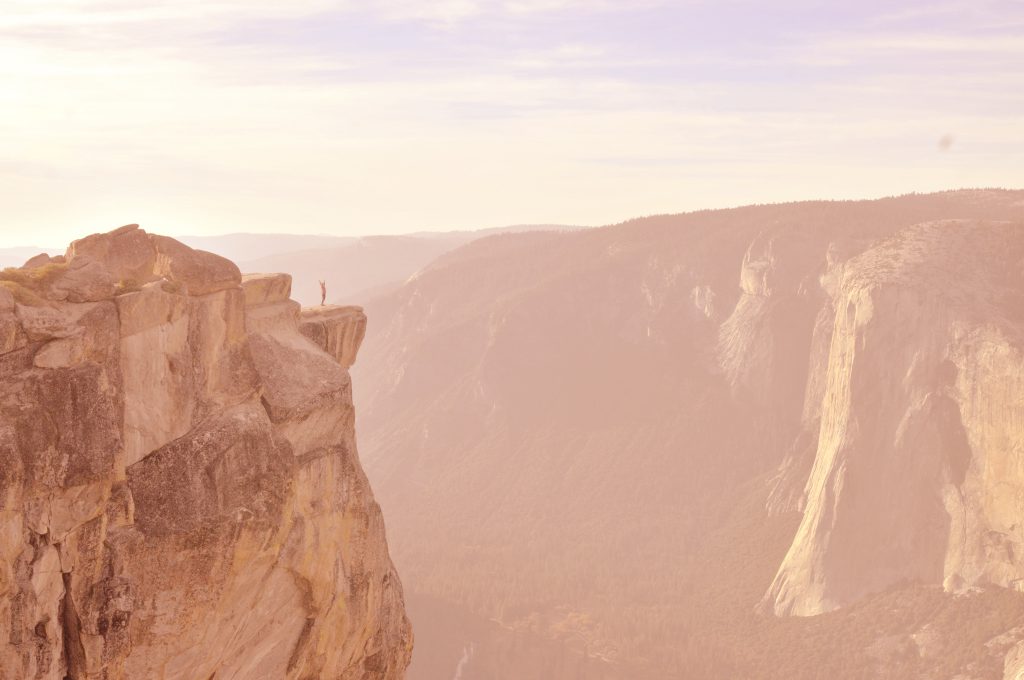
How to Get Around in Yosemite National Park
While it will make your life soooo much easier to drive yourself around in Yosemite, the park does offer a shuttle service that stops at some of the most popular locations in the eastern Yosemite Valley. There is a second shuttle that services El Captan, the Four Mile Trail, and the Valley Visitors Center.
Generally, visiting Yosemite in the fall means that you encounter far fewer crowds and therefore much less traffic – which means that you will be able to park at the trailheads of your desired hikes. However, if you happen to be in Yosemite during crowded times, you may have to park at a different lot and take the shuttle over.
More information about shuttle service is available here.

Where to Stay Near Yosemite National Park
There are many accommodation options both in and around Yosemite National Park. One of the big advantages of visiting in the fall is that finding a place to stay will be much easier – and cheaper! – than visiting during peak season.
Generally speaking, the closer you are to Yosemite Valley, the more convenient. You will probably pay a little more for this convenience (but still much cheaper than in the summer), but you will save soooo much time!
Here are some recommended accommodation options when visiting Yosemite in the fall:
Accommodations Inside Yosemite National Park
Staying inside the park is definitely the most convenient – but rooms go FAST! Here are the properties inside Yosemite National Park that are open year-round
- The Ahwanee: Luxury accommodations – right within the park! The Ahwanee has a central location and fine dining in a historic property.
- Yosemite Valley Lodge: A traditional lodge at the base of the park. Offers several dining options and is in a central location close to some of the park’s highlights.

Places to Stay Near Yosemite National Park
These are some recommended places to stay which are relatively close to the park, which is the next best thing:
- Rush Creek Lodge: Several of my friends have stayed here (including my friend Jess, who makes me want to visit Yosemite in the winter!), and all of them have absolutely RAVED about it. The modern yet rustic property has cozy vibes, fireplaces, a heated pool, and an outdoor fire pit – with free s’mores! Definitely staying here next time I visit Yosemite.
- Yosemite View Lodge: Where we stayed when we visited. The property is a bit dated, but it’s a great choice for when you want to stay near the entrance of the park, but are on a budget. Each of the rooms have a balcony, and gotta admit, the views are pretty beautiful from here.
- Evergreen Lodge: This historic lodge is just outside the park entrance and offers cozy, warm cabins in an idyllic setting. All rooms have a large private deck, Alexa devices, and a “mountain chic” vibe. There’s also a pool and hot tub on premises.
Have you ever visited Yosemite in the fall? What are some of your favorite ways to spend fall in Yosemite?
You might also like:
One Perfect Day in Joshua Tree National Park
Things to Do in Grand Canyon North Rim
9 Epic Zion Hikes
50+ Fun Ideas for National Parks Gifts
Los Angeles Bucket List
San Francisco Bucket List
Like this post? Save this post about fall in Yosemite on Pinterest for later!
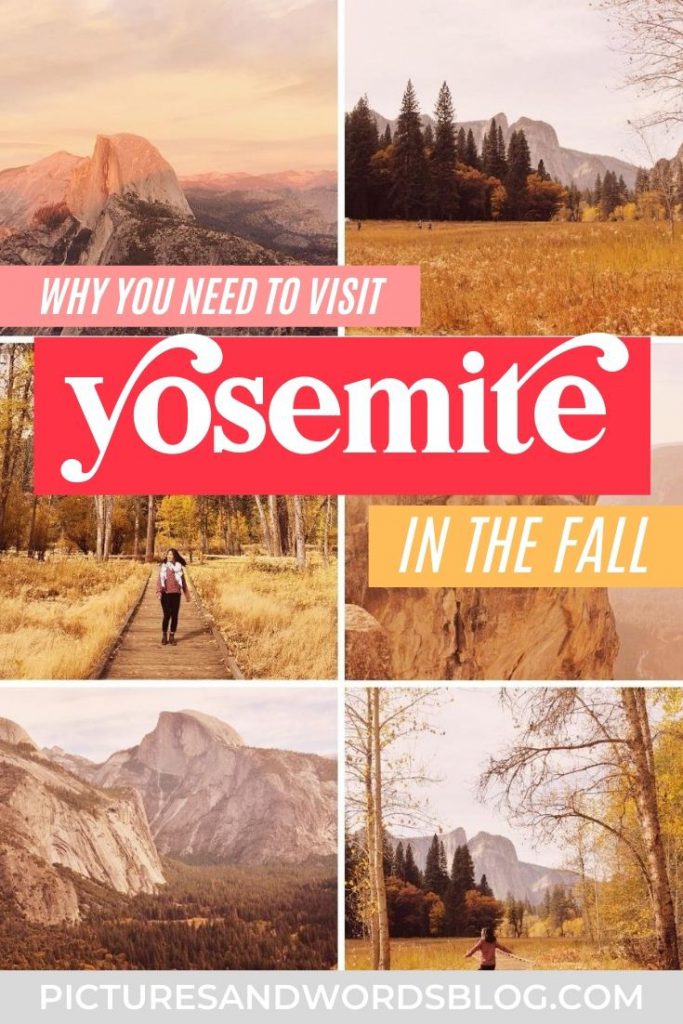





Caroline is a Southern California based traveler, writer, and photographer. She travels all around California, the US, and the world in search of the most colorful places, the most delicious food, and bucket-list adventures. Her aim is to inspire other travelers discover how to add more adventure and joy to their lives. On Pictures & Words, you’ll find detailed guides + itineraries, along with vibrant photos to help you plan the the most epic trips. When she’s not traveling, Caroline also runs half marathons.

Nell
Monday 27th of July 2020
These photos are stunning and definitely do the trick of persuading me to visit Yosemite, especially in the fall!
Charmaine Yip
Monday 27th of July 2020
Gorgeous photos! Thanks for sharing.
Kelly
Monday 27th of July 2020
Never thought of visiting Yosemite in the fall, but it looks so gorgeous with the orange hues! I haven't been yet so I'd love to visit anytime haha :)
Rowena
Sunday 26th of July 2020
Gorgeous photos! I'm going in a month. Not quite fall yet, but it's my first time in almost two decades (despite also living in SF for the past decade....), so I'm excited!
Diana
Sunday 26th of July 2020
I still haven't been to Yosemite but it looks simply stunning there! And your photos are so impressive would love to go there in fall time now.